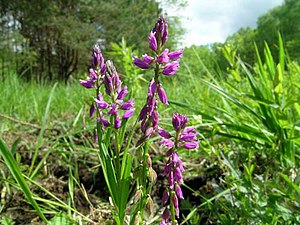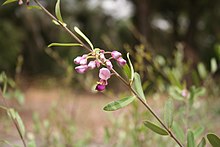Finials
| Finials | ||||||||||||
|---|---|---|---|---|---|---|---|---|---|---|---|---|

Scaly finial ( Polygala comosa ) |
||||||||||||
| Systematics | ||||||||||||
|
||||||||||||
| Scientific name | ||||||||||||
| Polygalaceae | ||||||||||||
| Hoffmanns. & Link |
The finial plants (Polygalaceae) are a family of plants in the order of the butterfly-like (Fabales). The approximately 21 genera with approximately 1000 species are distributed almost worldwide.
description

The family includes herbaceous plants and woody plants: trees , shrubs , less often lianas . Some species are root parasites . The alternate or opposite leaves are herbaceous to leathery. Stipules may be present or absent.
The flowers stand together in very differently structured inflorescences . The hermaphrodite , four or five-fold flowers are small to medium-sized, zygomorphic " butterfly flowers "; they are constructed quite differently from those of the Fabaceae . They each have four or five fused sepals and fused petals . They usually have eight, or rarely ten, stamens . Usually two (rarely up to eight) carpels have become a top permanent ovary grown. They form capsule fruits , less often stone fruits or nuts . The seeds contain oil.

Systematics and distribution
The finial family (Polygalaceae) occurs almost worldwide, except in the polar regions, Polynesia and New Zealand. There are around 400 species in the New World, around 206 in Africa, around 32 in Europe, around 70 in Asia and around 12 in Australia. In the Neotropic there are eleven genera with up to 470 species.
The family Polygalaceae was set up in 1809 by Johann Centurius Hoffmannsegg and Heinrich Friedrich Link in Flore portugaise ou description de toutes les ... , 1, p. 62. Type genus is Polygala L. Synonyms for Polygalaceae Hoffmanns. & Link nom. cons. are: Diclidantheraceae J.Agardh nom. cons., Moutabeaceae Endl. , Xanthophyllaceae Gagnep. ex Reveal & Hoogland
The family Polygalaceae is divided into four tribes and contains 21 genera with around 1000 to 1300 species :
- Tribe Xanthophylleae Chodat (formerly own family Xanthophyllaceae (Chodat) Gagnep. Ex Reveal & Hoogland ): It contains only one genus:
- Xanthophyllum Roxb. : The 95or sospecies are found in Southeast Asia , the Malay Archipelago and India . The plants accumulate Al ions.
- Tribe Carpolobieae Eriksen : It contains only two genera and six species in tropical Africa:
- Atroxima Stapf : The only two species occur in tropical West and Central Africa .
- Carpolobia G. Don f. : The four or so species occur in tropical Africa and Madagascar.
- Tribus Moutabeae Chodat (formerly own families Moutabeaceae Endl. And Diclidantheraceae J.Agardh ): It contains five genera and approx. 20 species in the Neotropic and from New Guinea to New Caledonia :
-
Balgoya Morat & Meijden : It contains only one species:
- Balgoya pacifica Morat & Meijden : It only occurs in New Caledonia.
-
Barnhartia Gleason : It contains only one species:
- Barnhartia floribunda Gleason : It occurs in tropical South America.
-
Eriandra P. Royen & Steenis : It contains only one species:
- Eriandra fragrans P.Royen & Steenis : It comes in Papua Sien ago
- Moutabea Aublet : The eight to ten species are common in the Neotropic .
- Diclidanthera C. Martius : The eight or so species are common in tropical South America .
-
Balgoya Morat & Meijden : It contains only one species:
- Tribe Polygaleae Chodat : It contains about 13 genera and about 830 species:
- Asemeia Raf. : 2012 weresubgenfrom the subgenus Polygala . Hebeclada (Chodat) SFBlake 28 species from the Neotropics placed in this own genus.
- Badiera DC. : The 10 to 15 species are common in the Neotropic.
- Bredemeyera Willd. : The approximately 15 species are common in the Neotropic.
- Comesperma Labill. : The approximately 30 species are common in Australia.
- Epirixanthes flower : it contains about five species.
-
Monnina Ruiz & Pavon : The 150 to 180 species occur between New Mexico and Chile, for example:
- Monnina salicifolia Ruiz & Pavon
- Muraltia DC. : The approximately 30 to 150 species are common in Africa.
- Nylandtia Dumort. : The only two types are common in South Africa.
- Phlebotaenia Griseb. : The threeor sospecies occur only in Puerto Rico and Cuba .
- Finials ( Polygala L. , Syn .: Acanthocladus Klotzsch ex Hassk. ): The 300 to 550 species almost worldwide, except New Zealand. (In 2012, from the subgenus Polygala subgen. Hebeclada (Chodat) SFBlake 28 species from the Neotropics were placed in a new genus Asemeia Raf. )
- Pteromonnina B. Eriksen : There are about 30 species in the Neotropic.
- Salomonia Lour. : The fiveor sospecies are common in Indomalesia and Australia.
-
Securidaca L .: The 60 to 80 species are widespread in the tropics, except in Australia.
- Wild violet tree ( Securidaca longipedunculata Fresen. )
family tree
| Fabales |
|
||||||||||||||||||||||||||||||||||||
|
|
literature
- The Polygalaceae family on the AP website. (Section systematics)
- The family of the Polygalaceae at DELTA. (Section Description)
- Shu-kun Chen, Haiying Ma, John AN Parnell: Polygalaceae. In: Wu Zheng-yi, Peter H. Raven, Deyuan Hong (Eds.): Flora of China. Volume 11: Oxalidaceae through Aceraceae . Science Press and Missouri Botanical Garden Press, Beijing / St. Louis 2008, ISBN 978-1-930723-73-3 , p. 139 (section description)
- Bente Eriksen, Claes Persson: Polygalaceae. In: Klaus Kubitzki (Ed.): The Families and Genera of Vascular Plants. Volume IX, Springer-Verlag, Berlin 2007, ISBN 978-3-540-32219-1 , pp. 345-363. doi : 10.1007 / 978-3-540-32219-1_41 Google-Books-online.
- Claes Persson, Bente Eriksen: Neotropical Polygalaceae. at Neotropikey - Interactive key and information resources for flowering plants of the Neotropics, 2009.
Individual evidence
- ↑ Polygalaceae at Tropicos.org. Missouri Botanical Garden, St. Louis, accessed July 29, 2013.
- ↑ Polygalaceae in the Germplasm Resources Information Network (GRIN), USDA , ARS , National Genetic Resources Program. National Germplasm Resources Laboratory, Beltsville, Maryland. Retrieved July 29, 2013.
- ↑ a b The family of the Polygalaceae on the AP website. (engl.)
- ↑ a b J. FB Pastore, JR Abbott: Taxonomic notes and new combinations for Asemeia (Polygalaceae). In: Kew Bulletin. Volume 67, Issue 4, pp. 801-813. doi : 10.1007 / s12225-012-9397-x



